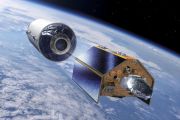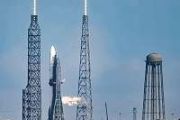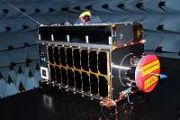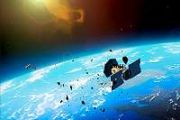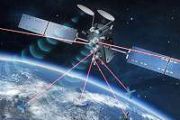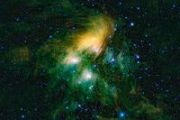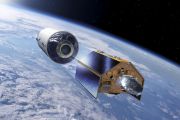
Copernical Team
Satellogic and SkyWatch increase access to timely earth observation data
 Satellogic Inc. (NASDAQ: SATL), has announced at World Satellite Business Week, their partnership to bring the highest resolution commercially available EO data to EarthCache customers.
Satellogic's EO data is now available via SkyWatch's EarthCache platform. EarthCache provides an intuitive interface and robust API that enables customers to browse archive data, as well as task new satelli
Satellogic Inc. (NASDAQ: SATL), has announced at World Satellite Business Week, their partnership to bring the highest resolution commercially available EO data to EarthCache customers.
Satellogic's EO data is now available via SkyWatch's EarthCache platform. EarthCache provides an intuitive interface and robust API that enables customers to browse archive data, as well as task new satelli GOES-U completes environmental testing
 GOES-U, the fourth and final satellite in NOAA's GOES-R Series of advanced geostationary satellites, recently completed rigorous testing to ensure it can withstand the harsh conditions of launch and orbiting in space 22,236 miles above Earth.
The testing process spanned nearly a year. During thermal vacuum testing, completed in November 2022, GOES-U was placed in a large 29-foot wide by 65
GOES-U, the fourth and final satellite in NOAA's GOES-R Series of advanced geostationary satellites, recently completed rigorous testing to ensure it can withstand the harsh conditions of launch and orbiting in space 22,236 miles above Earth.
The testing process spanned nearly a year. During thermal vacuum testing, completed in November 2022, GOES-U was placed in a large 29-foot wide by 65 Bayanat teams with HySpecIQ and AzurX for enable hyperspectral imaging for UAE
 HySpecIQ, a global leader in hyperspectral imaging and data analytics, hsa announced a partnership with Bayanat, an ADX-listed public company and leading provider of AI-powered geospatial solutions.
Hyperspectral imaging is a powerful technology that enables identification of objects from space. It takes advantage of the fact that all objects reflect light, both visible and beyond, in a un
HySpecIQ, a global leader in hyperspectral imaging and data analytics, hsa announced a partnership with Bayanat, an ADX-listed public company and leading provider of AI-powered geospatial solutions.
Hyperspectral imaging is a powerful technology that enables identification of objects from space. It takes advantage of the fact that all objects reflect light, both visible and beyond, in a un Will Sino-US space competition stop at Mars
 While attending a conference in the United States recently, I overheard an American expert discussing the space competition between China and the US. After the event, I approached the expert to inquire about the possibility of space cooperation between the two countries. His answer is a matter of concern. He explained that as long as the US Congress doesn't withdraw the ban it announced in 2011,
While attending a conference in the United States recently, I overheard an American expert discussing the space competition between China and the US. After the event, I approached the expert to inquire about the possibility of space cooperation between the two countries. His answer is a matter of concern. He explained that as long as the US Congress doesn't withdraw the ban it announced in 2011, Picogrid releases smallest AI-Enabled Command Station deployable in minutes
 Picogrid has taken the wraps off its latest innovation: Helios. This state-of-the-art hardware will be in the spotlight at the U.S. Army Military Police Regimental Association Conference at Fort Leonard Wood, MO.
Contained within a single, man-portable hard-shell case, Helios is a rapidly deployable platform that integrates high-bandwidth multi-network communications, onboard computing, an
Picogrid has taken the wraps off its latest innovation: Helios. This state-of-the-art hardware will be in the spotlight at the U.S. Army Military Police Regimental Association Conference at Fort Leonard Wood, MO.
Contained within a single, man-portable hard-shell case, Helios is a rapidly deployable platform that integrates high-bandwidth multi-network communications, onboard computing, an PLD SPACE signs a MOU with WISeKey to launch ultra-secure satellites with MIURA 5
 PLD Space, the company that designs, develops, manufactures and operates Europe's first private launcher, signs an agreement with WISeSat.Space, a subsidiary of WISeKey International Holding Ltd., the global leader in cybersecurity, AI, Blockchain and IoT, to launch the next generation of ultra-secure sub-500 kg satellites for Quantum-Ready Internet of Things (IoT) communications with the MIURA
PLD Space, the company that designs, develops, manufactures and operates Europe's first private launcher, signs an agreement with WISeSat.Space, a subsidiary of WISeKey International Holding Ltd., the global leader in cybersecurity, AI, Blockchain and IoT, to launch the next generation of ultra-secure sub-500 kg satellites for Quantum-Ready Internet of Things (IoT) communications with the MIURA Firefly Aerospace launches US Space Force VICTUS NOX Responsive Space Mission with 24-hours notice
 Firefly Aerospace, an end-to-end space transportation company, today announced the company successfully launched its Alpha rocket and deployed the VICTUS NOX spacecraft following a 24-hour notice to complete final payload operations and mission preparations.
Led by U.S. Space Force Space Systems Command's (SSC) Space Safari Program Office and in close partnership with the Rocket Systems La
Firefly Aerospace, an end-to-end space transportation company, today announced the company successfully launched its Alpha rocket and deployed the VICTUS NOX spacecraft following a 24-hour notice to complete final payload operations and mission preparations.
Led by U.S. Space Force Space Systems Command's (SSC) Space Safari Program Office and in close partnership with the Rocket Systems La ESA looks to transform Europe’s space transportation capability

On Earth, raw materials and finished goods move from source to destination with the help of a highly developed logistics network. ESA believes the same will be true in space in the future – made possible by a new generation of reusable launchers, in-space delivery vehicles and orbiting fuel depots.
AWS ties up with ISRO and IN-SPACe to advance India's space capabilities with cloud technologies
 Amazon Web Services (AWS) India Private Limited has signed a strategic Memorandum of Understanding with the Indian Space Research Organization (ISRO) and Indian National Space Promotion and Authorization Centre (IN-SPACe) to support space-tech innovations through cloud computing. This collaboration will give space startups, research institutes and students access to cutting edge cloud technologi
Amazon Web Services (AWS) India Private Limited has signed a strategic Memorandum of Understanding with the Indian Space Research Organization (ISRO) and Indian National Space Promotion and Authorization Centre (IN-SPACe) to support space-tech innovations through cloud computing. This collaboration will give space startups, research institutes and students access to cutting edge cloud technologi Every Gram Counts: SCHOTT Launches Lightweight Microelectronic Packages for Aerospace
 In today's fast-paced commercial aerospace market, companies need materials that are both lightweight and durable enough to withstand hostile, demanding environments. SCHOTT's new lightweight microelectronic packages meet this challenge by delivering the same reliable, long-lasting protection for avionics while slashing their weight by up to two-thirds compared to traditional electronic packagin
In today's fast-paced commercial aerospace market, companies need materials that are both lightweight and durable enough to withstand hostile, demanding environments. SCHOTT's new lightweight microelectronic packages meet this challenge by delivering the same reliable, long-lasting protection for avionics while slashing their weight by up to two-thirds compared to traditional electronic packagin 

